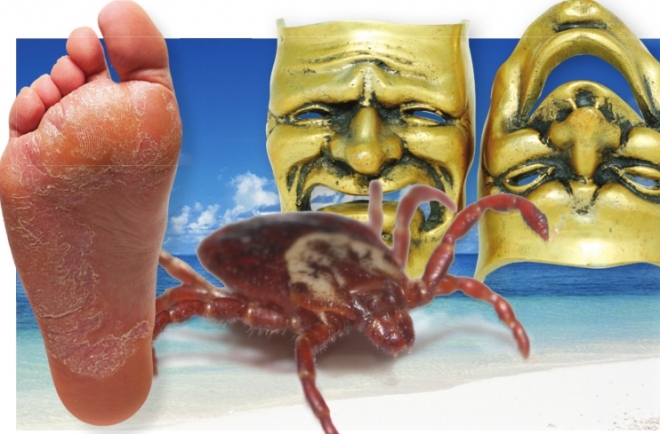HEALTHY GEEZER

Treating athlete’s foot and other disorders
Q. What bacteria causes athlete’s foot?
Athlete’s foot is not caused by bacteria. It is caused by tinea, a fungus that also can give you jock itch and ringworm. You can catch it from another person, from animals or wet surfaces such as the floors of public showers.
Athlete’s foot symptoms include dry skin, itching, burning, scaling, inflammation and blisters. If blisters break, tissue becomes exposed, and this can be painful.
Athlete’s foot usually shows up between the toes, especially the last two toes. Tinea thrives on feet because they are usually in shoes, which are perfect for fungus—they are warm, dark and humid.
The fungus can spread on the feet. It can also travel to other parts of the body if you scratch your feet and then touch elsewhere.
For a mild case of athlete’s foot, your doctor may recommend an over-thecounter or prescription preparation. There are antifungal sprays, powders, creams and lotions.
If you have a severe case of athlete’s foot, your doctor may prescribe an oral medication.
Q. In what parts of the country are you most likely to get Lyme disease?
The federal government’s Centers for Disease Control and Prevention (CDC) has identified the Northeast, the upper Midwest and the West Coast as the places you’re most likely to get Lyme disease.
Lyme disease is caused by bacteria spread by bites primarily from deer ticks, which are brown and often no bigger than a pin head. The disease was named for a Connecticut town where it was first recognized in 1975.
Lyme disease can cause fever, headaches, fatigue, joint pain, sore muscles, stiff neck and a skin rash that usually begins where the tick dug in. The rash may start out as a small red spot that can get bigger. A ring within the spot can fade and create a “bull’s eye.” Some people with Lyme disease get many red spots.
If you don’t treat Lyme disease, it can spread to the heart, joints and the nervous system. Patients with late Lyme disease can suffer permanent damage. If Lyme disease spreads to the heart, the person may feel an irregular or slow heartbeat. The disease is rarely fatal.
Lyme disease is treated with antibiotics.
In most cases of early Lyme disease, two to four weeks of oral antibiotics kill the bacteria. If the disease has progressed, your doctor may recommend an intravenous antibiotic for two to four weeks. This IV treatment is usually effective, although it may take some time to recover.
Q. What causes bipolar disorder?
It’s not known what causes bipolar disorder, but a variety of biochemical, genetic and environmental factors seem to be involved in causing and triggering bipolar episodes.
Bipolar disorder – also called manicdepressive illness – causes extreme mood swings. When people with bipolar disorder are happy and energetic, they are in the mania phase of the illness. When they are sad and listless, they are in the depression phase.
The shifts from mania to depression and back again can occur quickly. The deep mood swings of bipolar disorder may last for weeks or months. Often, there are periods of normal mood in between.
Sometimes, severe episodes of mania or depression include symptoms of psychosis such as hallucinations. Some people with bipolar disorder become suicidal.
Some studies indicate that people with bipolar disorder have physical changes in their brains. And researchers are trying to find genes that may be involved in the condition.
Fred Cicetti is a freelance writer who specializes in health. He has been writing professionally since 1963. Before he began freelancing, he was a reporter and columnist for three daily newspapers in New Jersey. If you would like to ask a question, write to fred@healthygeezer.com.
